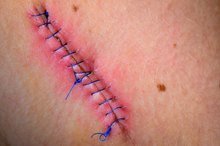Care for a Puncture in the Roof of the Mouth
Injuries to the roof of the mouth may affect the hard palate, an immovable vault attached to the upper teeth, or the soft palate, which is near the back of the throat. Deeper tissues may be involved, especially in puncture injuries to children caused by the sticks of flavored ice or pencils. Usually, however, such wounds look much worse than they are, due to these areas' tendency to bleed heavily. Treatment at home should focus on stopping the bleeding, controlling pain and preventing infection.
Assessment
If there is rapid swelling of the throat or tonsils or any difficulty breathing, seek emergency treatment at once. Head injuries and injuries to the back of the throat can be serious and should be assessed by a health care professional. Vomiting, confusion and coma indicate neurological damage.
If the injury in the roof of the mouth cannot be visualized or there is any possibility that foreign matter remains in the puncture wound, emergency care should be sought. Be sure also to check for loose or missing teeth. Lacerations more than an inch long or those that continue bleeding should be professionally treated.
Most puncture wounds to the roof of the mouth heal quickly and don't need stitches. Use a clean piece of gauze to apply pressure over the wound to stop bleeding; alternatively, push the tongue against the wound. A cold compress will relieve swelling and pain. A piece of ice wrapped in gauze can be held against the roof of the mouth with a finger or the tongue. Sucking on ice or flavored ice may help. Sit upright or lean forward to minimize swelling and swallowed blood.
Comfort Measures
How to Heal Tongue Wounds
Learn More
Over-the-counter pain relievers such as acetaminophen or ibuprofen will help to control discomfort. When taking other regular medications for health conditions, consult your doctor to find out which pain reliever is best for you.
Avoid solid food for the following two days. Eat a diet of nutritious soft foods such as dairy products, puddings, custards, shakes, yogurt, ice cream, tender meats and eggs, creamy nut butters, soft ripe or canned fruits, bananas, avocados, yams and cooked mashed carrots and potatoes. Acid fruits, tomatoes and spicy foods might burn and are best avoided, as are foods that stretch the mouth wide, like large apples or sandwiches. After meals, rinse the mouth with a saline solution of one teaspoon salt to one cup of warm water. According to the American Academy of Pediatrics, saltwater rinsing relieves pain and inhibits the growth of bacterial colonies, helping to prevent infection. Healing should take place within four or five days.
Do not hesitate to see or return to a doctor if the wound does not seem to be healing well, especially if there is drainage, redness, warmth, increased swelling or worsening pain, as these are signs of infection. Mouth problems that may be related to the injury should also be evaluated by a doctor or dentist. Be ready to give a history, including how and when the injury took place, what first aid measures or medications were used, and the results of those interventions. You also may be asked if there are any chronic illnesses, such as diabetes, which may affect healing. Tell your doctor if it has been more than five years since the last tetanus vaccine.
Related Articles
References
- Randal, DZ, et. al., Current Management of Penetrating Injuries of the Soft Palate, Otolaryngolical Head and Neck Surgery, Sep 2006, 135 (5)
- American Academy of Pediatrics, Pediatric First Aid for Caregivers and Teachers, Jones and Bartlett, 2006
Resources
Writer Bio
Mary Earhart is a registered nurse, a public health nurse and licensed midwife. Her articles have appeared in professional journals and online ezines. She holds a Bachelor of Science in nursing from California State University at Dominguez Hills. She works in a family practice clinic, has a home birth practice and her specialty is perinatal substance abuse.









